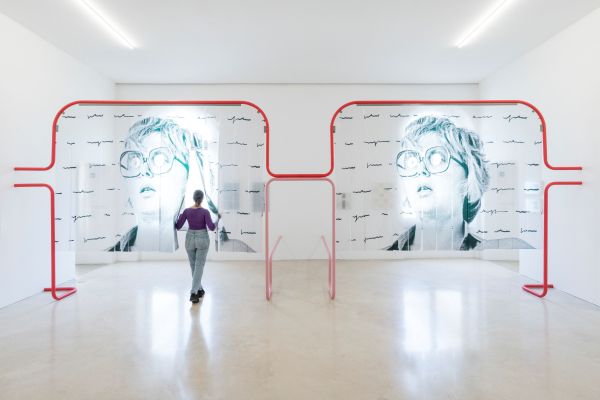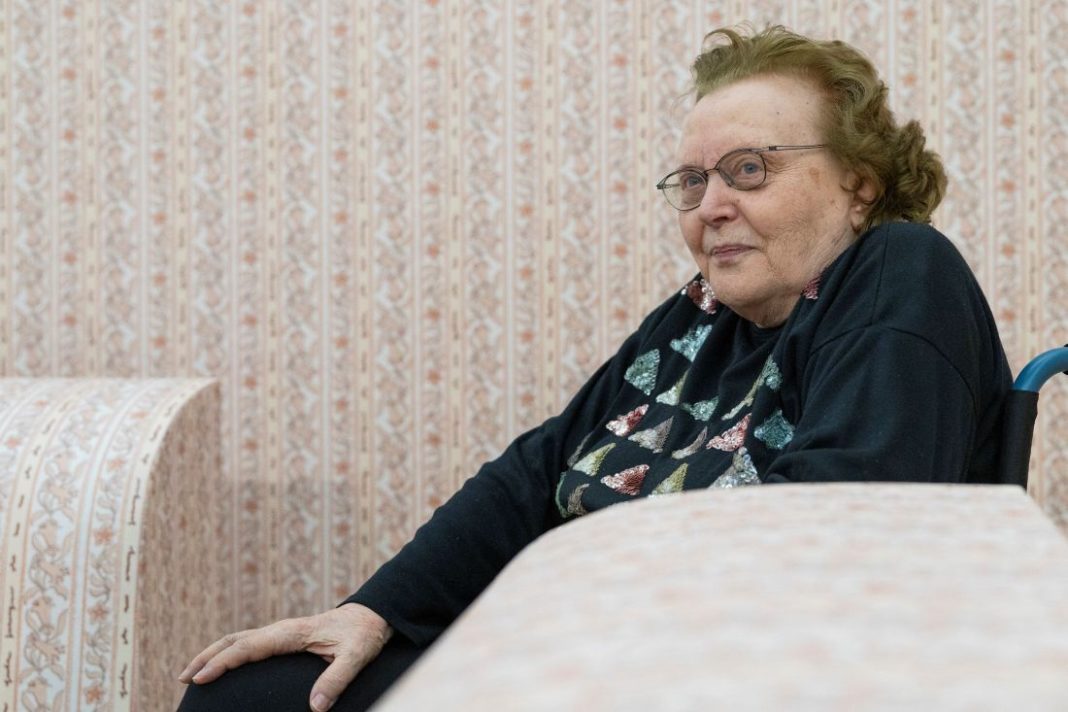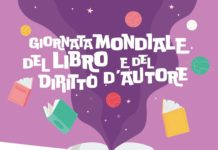Si può essere giovani a oltre 90 anni? La risposta affermativa ce la dà la mostra Euforia Tomaso Binga(e la stessa artista presente all’anteprima stampa) a cura di Eva Fabbris con Daria Khan, exhibition design Rio Grande. Una parola importante questa, collegata all’autrice salernitana di cui la culla napoletana del contemporaneo ospita la carriera artistica che naviga in un lungo tempo.
Nata a Salerno nel 1931, come Bianca Pucciarelli, sposa lo storico dell’arte Filiberto Menna, si trasferisce a Roma e giocando con i suoni, con la fonetica e con la scrittura diventa Binga, poi declinato al maschile come Tomaso: una provocazione, negli anni settanta. La sua ironia spiazza volutamente il pubblico, insistendo sul privilegio di essere maschi nell’universo artistico.
Come spiega lei stessa: «Una contestazione per via di paradosso di una sovrastruttura che abbiamo ereditato e che, come donne, vogliamo distruggere. In arte, sesso, età, nazionalità non dovrebbero essere delle discriminanti. L’Artista non è un uomo o una donna ma una PERSONA».
Ed eccola allora tutta la personalità di una figura madre nelle battaglie femministe mai pedanti ma gioiose, pietra miliare che oltrepassa qualsiasi confine spaziotemporale: il pubblico potrà passeggiare tra oltre centoventi opere. Installazioni, fotografie, collage, documenti, testimonianze di performance – molte delle quali mostrate per la prima volta o a decenni di distanza dalla loro prima esposizione – provenienti da musei e collezioni private.
Euforia è una parola che Binga ama molto perché contiene tutte le vocali: «Foneticamente universale ed estroversa – commenta la curatrice Fabris – diventa un titolo-manifesto, un augurio, una necessità politica di resistenza e contraddistingue tanto il suo approccio alla pratica verbo-visuale quanto al femminismo».
L’esposizione che si apre oggi e resterà fino al 21 luglio nel palazzo di via Settembrini è frutto di due anni di ricerche realizzate in stretta collaborazione con l’artista e il suo archivio.
Il percorso espositivo si sviluppa nelle diciotto sale del terzo piano del museo con un allestimento sperimentale dal tracciato circolare ideato dal collettivo multidisciplinare Rio Grande in dialogo con Tomaso Binga, concepito secondo criteri di affinità grafici, visivi e tematici
Accompagna la mostra Il libro edito da Lenz Press in italiano e inglese, è a cura di Eva Fabbris, Lilou Vidal e Stefania Zuliani. È articolato in tre parti: la prima presenta saggi e un’intervista all’artista; la seconda una serie di brevi testi critici che analizzano opere singole o piccoli corpus di lavori delle principali aree di interesse dell’artista; la terza è dedicata alla poesia visiva.
La mostra sarà arricchita da laboratori creativi per bambini organizzati dal dipartimento Educativo del museo Madre. Un calendario di appuntamenti gratuiti, compresi nel biglietto di ingresso del museo, che proseguirà parallelamente alla mostra, a cui si potrà partecipare prenotando ogni appuntamento sul sito eventbrite.it.
Domani, sabato 19 aprile (dalle 12 alle 13, dai 6 ai 10 anni) ci sarà quello intitolato “Io sono, io sono, io sono”, abbinato a una visita alla mostra. I piccoli potranno inventare un proprio alter-ego, attraverso schede e disegni a mano libera.
Sabato 26 aprile (dalle ore 12 alle ore 14. Per bambini dai 5 ai 12 anni) nell’ambito del progetto family, il museo Madre offre a tutte le famiglie il laboratorio creativo “Ritratti e autoritratti”, che prende spunto dai “Ritratti analogici” di Tomaso Binga, per riflettere insieme ai più piccoli su come sia possibile ritrarre una persona (un amico, un parente) attraverso l’assemblaggio di più elementi che ne evidenzino i tratti distintivi.
Anche per gli adulti, domenica 20, giorno in cui si celebra la Pasqua, e domenica 27 aprile visite guidate gratuite comprese nel biglietto di ingresso del museo da prenotare sempre su eventbrite.it.
Per saperne di più
Read more at
www.madrenapoli.it

Madre Museum/ The Euphoria of being a Feminist: an exhibition of more than 120 works by Tomaso Binga (Bianca Pucciarelli Menna). The political and artistic necessity of resistance
Can you be young at over the age of 90? The answer is yes, says the exhibition Euforia Tomaso Binga (and the artist himself was present at the press preview), curated by Eva Fabbris with Daria Khan, exhibition design Rio Grande. An important word in relation to the Salerno-born artist, whose artistic career has spanned a long period in the Neapolitan cradle of contemporary art.
Born in Salerno in 1931 as Bianca Pucciarelli, she married the art historian Filiberto Menna, moved to Rome and, playing with sounds, phonetics and writing, became Binga, later receding into the male form as Tomaso: a provocation in the 1970s. Her irony deliberately unsettles the public, insisting on the privilege of masculinity in the artistic universe.
As she explains: A paradoxical challenge to a superstructure that we have inherited and that we, as women, want to destroy. In art, gender, age, nationality should not be discriminatory factors. The artist is not a man or a woman, but a PERSON”.
And here is the whole personality of a mother figure in the feminist struggles that are never pedantic, but joyful, a milestone that transcends any space-time boundary: the public will be able to wander through more than one hundred and twenty works. Installations, photographs, collages, documents, testimonies of performances – many of them shown for the first time or decades after their first exhibition – from museums and private collections.
Euphoria is a word that Binga loves because it contains all the vowels: “phonetically universal and extroverted,” comments curator Fabris, “it becomes a title manifesto, a wish, a political necessity of resistance, and distinguishes both her approach to verbo-visual practice and to feminism.
The exhibition, which opens today and lasts until the 21st of July in the Via Settembrini building, is the result of two years of research carried out in close collaboration with the artist and his archive.
The itinerary of the exhibition unfolds in the eighteen rooms on the third floor of the museum, with an experimental circular layout conceived by the multidisciplinary collective Rio Grande in dialogue with Tomaso Binga, according to criteria of graphic, visual and thematic affinities. The exhibition is accompanied by a book published by Lenz Press in Italian and English, edited by Eva Fabbris, Lilou Vidal and Stefania Zuliani. It is divided into three parts: the first presents essays and an interview with the artist; the second is a series of short critical texts analysing single works or small groups of works from the artist’s main areas of interest; the third is dedicated to visual poetry.
The exhibition will be enriched by creative workshops for children organised by the Madre Museum’s Education Department. The exhibition will be accompanied by a calendar of free events, included in the museum ticket, which can be booked on the eventbrite.it website.
Tomorrow, Saturday the 19th of April (from 12 to 13, from 6 to 10 years old), there will be an event called “I am, I am”, combined with a visit to the exhibition. Children will be invited to create their own alter ego through cards and freehand drawings.
On Saturday the 26th of April (from 12 to 2 p.m. for children aged 5 to 12), as part of the Family Project, the Madre Museum offers all families the creative workshop “Portraits and Self-Portraits”, inspired by Tomaso Binga’s “Analogue Portraits”, to reflect together with children on how it is possible to portray a person (a friend, a relative) by assembling several elements that highlight their distinctive features.
Also for adults, on Sunday the 20th, the day of Easter, and on Sunday the 27th of April, there will be free guided tours included in the museum ticket, which can be booked on eventbrite.it.










